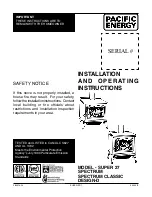
24
Insufficient firing
If the fireproof materials in the combustion chamber are blackened after a fire, then the stove is pol-
luting, and the automatic air flow regulating system is malfunctioning. It will be necessary, therefore,
to open the thermostatic controller. It may also be necessary to burn more wood.
Cleaning the glass
We recommend wiping the glass after a fire. This is best done using a paper towel.
Be aware that using fuels other than wood will cause soot to form on the glass!
Types of fuel
We recommend using birch or beechwood, which has been split and stored for at least one year
outdoors under cover. Wood stored indoors tends to become too dry and burn too quickly.
Briquettes give off a lot of heat. Certain types expand considerably, thus causing an uncontrollable
combustion.
Briquettes are very poor in gas.The air damper in the door can therefore be closed almost complet-
ely down. Furthermore, briquettes are good when terminating the firing of the day, as they can burn
throughout the night.
The stove is EN-approved for firing wood only. No particle board, lacquered, painted or
treated wood, plastics, or rubber may be burned.
m
aIntenance
Maintenance
Any maintenance of the stove should only be carried out when it is cold. Daily maintenance is limited
to vacuum cleaning the stove externally, using the soft brush attachment. You can also dust the stove
using a dry, soft cloth or brush, but on a cold stove only.
Once a year, the stove should be thoroughly serviced. The combustion chamber should be cleared of
ashes and soot. Door and fittings should be lubricated using a copper-based grease.
Cleaning
(Drawing A)
Prior to sweeping, dismount the smoke shelf, so that soot and ashes can be swept down into the
combustion chamber. After the sweeping of the chimney, clean the combustion chamber, and after-
wards remount the smoke plate. It is very important for the function of the stove that these are
mounted correctly.
• Remove one of the side stones and take out the smoke shelf (2).
• Open the by-pass damper (1). Ashes and soot from the sweeping will fall down partly in the
combustion chamber, partly lie on the by-pass damper from which it is easy to sweep the ashes
and the soot down into the combustion chamber.
• If the stove has a baking section, the by-pass (7) rod of the baking section is also pulled out prior
to sweeping.
• The cleaning, if any, of the sides of the baking section follows through the holes to the cooking
rings.
• Before cleaning the surrounding flues of the stove, the side plates of the combustion chamber are
removed. This is done by taking the rear edge of the side plates and pull them towards the middle.
Summary of Contents for Hwam Classic 4
Page 2: ......
Page 4: ...A C B D C B A A1 A2 4...
Page 5: ...D D1 D2 5...
Page 13: ...34...
Page 14: ......
Page 15: ......
Page 16: ...www hwam com...


































